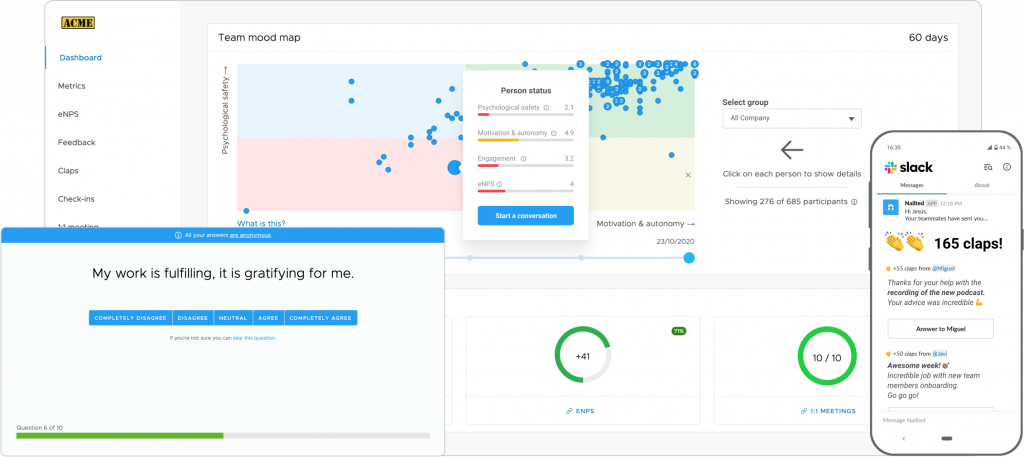Working remotely has become an important part of life for so many people around the world, leading to the adoption of asynchronous communication.
Whether your employees prefer to work remotely because of caring responsibilities, a desire to travel, or just a preference for the quiet being away from the office, it’s certainly a popular choice that comes with many benefits.
This approach requires employees to think again when it comes to communicating and collaborating with their colleagues. Whilst you might have just walked up to someone in the office and asked them for their input, you’ll now need to consider if your coworker is even at their desk at all. As well as the added complication of different time zones.
This can mean that you need to change the way you communicate, in order to get the job done efficiently. But, what are the different types of communication? And how can you get used to asynchronous communication when working remotely? Let’s take a look at it!
Synchronous vs asynchronous communication – what are the differences?
When it comes to communication, there are two main types: synchronous and asynchronous (also referred to as async). Synchronous communication happens in real-time, such as a phone call or video chat.

Asynchronous communication does not occur in real-time. Instead, it involves sending messages that can be read and responded to at the recipient’s convenience. Email, text messaging, and social media are all examples of asynchronous communication.
Additionally, asynchronous communication follows a process of documentation and transparency, with individuals defaulting to written communication for clarity when handing over work tasks.
What are the benefits of asynchronous communication?
Both types of communication have their own advantages and disadvantages, and of course these will have a different level of impact for every individual. What seems like a benefit for someone may be isolating for others.
- Offers flexibility: the main benefit of asynchronous communication is the flexibility it offers.Taking away the immediate need to reply allows workers to choose how to structure their own working day. By giving their teams this freedom, businesses may find it boosts a feeling of trust and empowerment.
- Boosts focus: this approach can also help boost focus, and therefore help workers remain happy and productive, as they only reply to communication when they choose to. Whilst this makes things tricky if you need a quick response, it has the potential to boost confidence in junior workers who would otherwise default to letting someone else take the lead. Additionally, it means that everyone should assume that the person they are working with won’t be available at the exact moment they need – improving their ability to plan ahead.

- Promotes inclusion: asynchronous work can also make your company more inclusive. Not everyone thrives off a busy, meeting-heavy environment – plenty of introverts and neurodiverse people in particular get their best work done in a quieter atmosphere. By removing the requirement to be in a chatty office, or constantly on video calls, you give people the opportunity to work in the way that suits them best.
What are the challenges of asynchronous communication?
Whilst you might think that the benefits make asynchronous communication sound like a perfect solution, it isn’t the right choice for everyone. It can feel isolating for those that like the constant hum of working chat.
Also, many people find that they come up with their best ideas on a spur of the moment conversation around the table. This just isn’t possible with asynchronous communication. For this reason, it may mean that team members miss out on the opportunity to be involved in conversations if they’re not already assigned to the project.
There’s also the undeniable fact that asynchronous communication can mean that you’re waiting for another team member to input on a problem. Unless you happen to be working at the same time. Whilst your autonomy will be increased, there will likely still be situations where you need to talk it through with colleagues.
Finally, async can sometimes lead to miscommunication if messages are not clear, or would benefit from body language or tone of voice. This can then take a while to sort out, as you’re waiting for the person to come back online. Especially if someone gets irritated or offended by a message, this can foster bad feelings over a longer period of time than necessary.

Working remotely: How can companies implement asynchronous communication?
Everyone has to make a commitment
It’s important to realize that asynchronous communication cannot be implemented overnight, nor will it necessarily be a smooth process. For asynchronous communication to work, everyone needs to be committed to the process, and guidelines need to be set to make sure that communication is as effective as it can possibly be.
The way in which information is shared must change
When it comes to getting yourself in the mindset of asynchronous communication, tech company GitLab recommends asking yourself ‘how would I deliver this information if no one in my team were awake?’.
This might seem a challenging process if you can see your coworkers are online, but it’s vital for making sure that everyone has the same experience. Otherwise, those who aren’t on the call will miss out.
Use project management tools
Asynchronous communication also works best when you’re working on multiple projects. As otherwise you can be waiting for someone to reply to you, which blocks your own workflow.
Companies should use project management tools to schedule multiple tickets, whilst still managing capacity. All work requests should go through this tool, so that nothing gets missed.
Use employee engagement software
When using asynchronous communication you may find it more difficult to understand how your people feel. The reality is that when working remotely, understanding your team becomes vital. That’s why you need to define clear communication and feedback routines.
This will help you make sure that you are looking out for everyone and that your remote employees feel motivated and engaged at all times.

When should you use synchronous communication rather than asynchronous communication?
As we’ve explored, there are clear benefits to both synchronous and asynchronous communication. A good guideline for deciding whether to have a meeting or not is to look at whether the meeting is relevant for discussion, rather than just instruction. Consider whether you’re just going to take someone’s time away when they could be working on something else.
If you do decide to hold a meeting, then you should have a clear agenda to keep things running smoothly and efficiently.
Ultimately, the best type of communication depends on the situation and the needs of the people involved. However, moving towards asynchronous communication when working remotely has led to new working methodologies, helping everyone balance their own workload, and increasing efficiency and productivity.
Remote work has given rise to new communication methodologies, such as asynchronous communication. But it has also given rise to new aspects that we need to take into account to ensure that our employees’ experience remains as satisfying as before.
If you’re switching from in-office to hybrid or remote work and are struggling to manage and engage people, we’re here to help. Talk to one of our experts and we’ll help you take care of your people now that asynchronous communication is your new reality.










